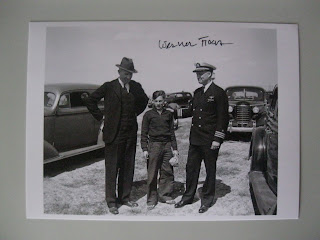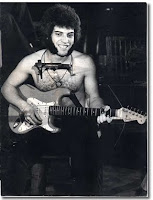Werner Franz was a 14-year-old cabin boy
when he survived the destruction of the "Hindenburg" in 1937. Franz was cleaning china in
the officers' quarters when the 804-foot-long German ship, held
aloft by hydrogen, caught fire over Lakehurst, N.J. He escaped by
breaking through the cloth of a nearby hatch.

He is now the only survivor of the Hindenburg"s crew that survived the 1937 disaster.
The following story is from the Stars and Stripes archives, published in 1987:
THE HINDENBURG'S 15-year-old cabin boy was cleaning china in the
officers' quarters when an explosion in the rear of the 804-foot airship
shook it from front to back.
Fifty years-later, Werner Franz remembers exactly what happened.
"All the china came flying out of the cabinets," he said.
Franz ran out into a passageway. There was no time to be scared.
"It happened so fast, it was like a movie passing by," he said. "You act instinctively.
As the ship began to lurch at its mooring, he grabbed a girder and dangled in the air.
"As I hung there, I had a vision of my life passing by," he said.
The
Hindenburg was engulfed in flames, the tail crashing to the ground and
the nose settling more slowly as Franz made his way, coughing and
choking, to the nearest hatch.

Pull cords opened the thick cloth
covers of the hatches, but Franz didn't use one. "I just jumped," he
said. "The cloth broke through. When the cook (Xaver Meier) saw me jump
out of the hatch, he jumped out after me."
Franz stumbled away from the burning airship.
"When
I got out, there were so many people running around screaming," he
said. "I was in a daze. Some of the landing crew went inside the ship to
help the crew and passengers get out."
Franz normally would have
been in a landing detail that required several crewmembers to move to
the nose of the ship as ballast. "This time six or eight men were sent
to the front by the captain — all died," he said.
News of the Hindenburg disaster quickly reached Germany.
"My
parents knew right afterwards what had happened — it was on the radio
wires," he said. "At first I was on the death list. An hour later they
updated it."
Franz and the other surviving crewmen spent 14 days at the air station, living with the Lakehurst airship crew.
The Germans were then driven to New York and put on a ship for Bremerhaven.
"The healthy ones came back first, and the badly burned ones came back later," he said:
Most
of the crew transferred to the Graf Zeppelin I, built before the
Hindenburg, upon returning to Germany. The Graf Zeppelin made 40
flights, delivering mail and making publicity appearances. It carried no
passengers, and was dissembled in Frankfurt in 1940.

Franz chose
to work in the airship ticket office in Zeppelinheim, Germany, then
started an apprenticeship as an instrument maker. He joined the German
air force in 1941.
Now retired, Franz lives in Bad Soden, a town
near Frankfurt. He
said six or eight Hindenburg crewmembers are still alive. All live in
Germany, except one man who lives in Austria or Switzerland, he said.
Franz keeps in touch with some of them.
"Most have contact, know where the others live," he said. "We had close ties between us all."
Franz
said he prefers to remember the thrill of being a young boy traveling
by airship to South America rather than the disaster. He was chosen for
airship duty by an official of the Luftschiffbau Zeppelin (Airship
Construction Company Zeppelin) who looked for prospective crewmembers at
the Frankfurter Hof hotel, where Franz worked as a waiter.
When
the opportunity to join the Hindenburg crew came, Franz was ready. "It's
a one-shot deal," he said. "You don't turn down a chance like that!"
He
made three trips between Germany and South America in 1936 and one in
1937. All of the crewmembers were considerably older than he was — the
rest of the crew survivors are in their 80s. "But they took me in as one
of them," he said.

An official review board determined the
Hindenburg disaster to be freak accident. Franz, however, like many
others, believes sabotage was involved. "To have the gas released from a
hole, then you need a spark, to have all those things at the same time,
just as you're landing ..."
But he believes the question is academic now.
"It doesn't really matter," he said. "It's already happened. It will always be a question."
The
Hindenburg disaster took place on Thursday, May 6, 1937, as the German passenger airship
LZ 129 Hindenburg caught fire and was destroyed during its attempt to dock with its
mooring mast at the
Lakehurst Naval Air Station, which is located adjacent to the borough of
Lakehurst, New Jersey. Of the 97 people on board
[N 1] (36 passengers, 61 crew), there were 35 fatalities; there was also one death among the ground crew.
The disaster was the subject of spectacular
newsreel coverage, photographs, and
Herbert Morrison's
recorded radio eyewitness report from the landing field, which was
broadcast the next day. A variety of hypotheses have been put forward
for both the cause of ignition and the initial fuel for the ensuing
fire. The incident shattered public confidence in the giant,
passenger-carrying rigid
airship and marked the end of the airship era.
At 7:25 p.m. local time, the
Hindenburg caught fire and quickly became engulfed in flames.
Where the fire started is unknown; several witnesses on the port side
saw yellow-red flames first jump forward of the top fin, around the vent
of cell 4.
Other witnesses on the port side noted the fire actually began just
ahead of the horizontal port fin, only then followed by flames in front
of the upper fin. One, with views of the starboard side, saw flames
beginning lower and farther aft, near cell 1. No. 2 Helmsman Helmut Lau
also testified seeing the flames spreading from cell 4 into starboard.
Although there were five newsreel cameramen and at least one spectator
known to be filming the landing, no camera was rolling when the fire
started.
Wherever it started, the flames quickly spread forward. Instantly, a
water tank and a fuel tank burst out of the hull due to the shock of the
blast. This shock also caused a crack behind the passenger decks, and
the rear of the structure imploded. Buoyancy was lost on the stern of
the ship, and the bow lurched upwards as the falling stern stayed in
trim.
As the
Hindenburg's tail crashed into the ground, a burst of
flame came out of the nose, killing nine of the 12 crew members in the
bow. There was still gas in the bow section of the ship, so it continued
to point upward as the stern collapsed down. The crack behind the
passenger decks collapsed inward, causing the gas cell to explode. The
scarlet lettering "Hindenburg" was erased by flames while the airship's
bow descended. The airship's gondola wheel touched the ground, causing
the bow to bounce up slightly as one final gas cell burned away. At this
point, most of the fabric on the hull had also burned away and the bow
finally crashed to the ground. Although the hydrogen had finished
burning, the Hindenburg's diesel fuel burned for several more hours.

The time it took for the airship to be destroyed has been disputed.
Some observers believe it took 34 seconds, others say it took 32 or 37
seconds. Since none of the newsreel cameras were filming the airship
when the fire started, the time of the start can only be estimated from
various eyewitness accounts. One careful analysis of the flame spread by
Addison Bain of
NASA
gives the flame front spread rate across the fabric skin as about
49 ft/s (15 m/s), which would have resulted in a total destruction time
of about 16 seconds (245 m / 15 m/s=16.3 s). Some of the duralumin
framework of the airship was salvaged and shipped back to Germany, where
it was recycled and used in the construction of military aircraft for
the
Luftwaffe, as were the frames of the
LZ 127 Graf Zeppelin and
LZ 130 Graf Zeppelin II when both were scrapped in 1940.
The disaster is well recorded due to the significant extent of
newsreel coverage and photographs, as well as
Herbert Morrison's eyewitness radio report for station
WLS
in Chicago, which was broadcast the next day. Heavy publicity about the
first transatlantic passenger flight of the year by Zeppelin to the
U.S. attracted a large number of journalists to the landing. (The
airship had already made one round trip from Germany to Brazil that
year.)
Morrison's broadcast remains one of the most famous in history. Parts
of it were later dubbed onto the newsreel footage, giving the
impression that the words and film were recorded together. His plaintive
"Oh, the humanity!" has been widely used in popular culture. Part of
the poignancy of his commentary is due to its being recorded at a
slightly slower speed, so that when it is played back at normal speed,
it seems to have a faster delivery and higher pitch. When corrected, his
account is less frantic sounding, though still impassioned.




